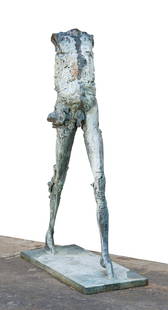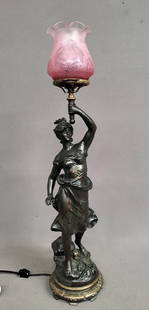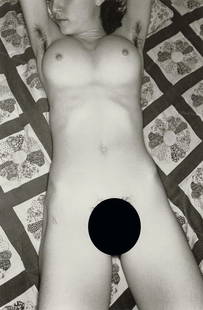
Isabelo L. Tampinco (1850 - 1933)
Similar Sale History
View More Items in Sculptures & CarvingsRelated Sculptures & Carvings
More Items in Sculptures & Carvings
View MoreRecommended Art
View More


Item Details
Description
Bewitching Pose
signed and dated 1908
marble
H:21” x L:8” x W:7”(53 cm x 20 cm x 18 cm)
Provenance:
Acquired directly from the artist’s grandaughter, Amparo Z. Tampinco
Isabelo Tampinco was a Filipino sculptor known for his woodcarvings for churches, most notably the Church of San Ignacio in Intramuros: altar, the pillars, the ceilings and the other intricate portions of the church; public edifices; and homes. Specific examples of his work were polychrome wood figures of saints and angels.
Among his works were Manila Cathedral’s famous facade, the high relief on Santo Domingo church’s molave door, the main altar of the Laoag Cathedral, and woodcarvings in San Agustin church. Out of a desire to create a uniquely Filipino style, he incorporated native flora and fauna designs in his sinuous openwork and Art Nouveau whiplash outlines style of woodcarving. Among his native motifs were the banahaw, areca palm, and bamboo. The said detail became known as “Tampinco frames.”
A Chinese mestizo and a direct descendant of Rajah Lakandula, he was born in Binondo, Manila. He was the son of Tampinco y delos Reyes and Maria Justa de Lacandola. He apprenticed in the carving shops of Binondo and Santa Cruz districts and was able to start his career in his 20s. His works dated as early as 1870. When Tampinco began his art, even while he was trained in school with a classical foundation, there was a revival of the gothic style in Europe. These styles became very evident in his design of churches, such as that of the fallen San Ignacio Church.
At age 26, he was chosen as the representative of the Philippines at the 1876 Philadelphia Centennial Exposition in the United States. In 1878 Tampinco landed an important commission- the undertaking of the historic Ayuntamiento which neded refurnishing. Tampinco worked on the statues, lions, the wooden crowns of state chairs and additional ornamentation for Queen Mercedes’ catafalque.
Receiving the “Diploma de Honor” given by the Royal Jury from the Exposicion General de las Islas Filipinas in Madrid, Spain in 1887, was said to be his most important recognition. Other awards and distinctions that Tampingco reaped were the Gold Medal at the Exposicion de Filipinas in 1895, another Gold Medal was at the St Louis Exposition in 1904.
When the Spaniards left and the American colonizers came, Tampinco enjoyed the newfound freedom as he was able to complete majority of his nude sculptures.Most of his works were either plaster of Paris or concrete. During the American Period, Tampinco was to land a few more commissions, including the interior decoration of the National Museum Building and later the Malacanang Palace in 1926 when he was already past his seventies.
This female figure from 1908 reflects a lot of Tampinco’s formal training.At age 15, he enrolled at the Academia de Dibujo y Pintura, Manila’s art academy, and studied sculpture under Agustin Saez and Lorenzo Rocha. He was hailed as one of the most outstanding sculptors of his time and was admired by Jose Rizal , who was his classmate in a modeling class at the Ateneo Municipal de Manila. He also had formal schooling at the Escuela de Artes y Oficios under the tutelage of Agustin Saez and Lorenzo Rocha. Escuela de Artes y Oficios was patterned after the Royal Academy of Painting and Sculpture which was established in 1648 by King Louis XIV of France. At this time (mid to turn of the 19h century) realism in the Classico-Romantic style was highly favored - an artistic style that was at the same time realistic, classical and romantic- an idealized version of the physical reality imbued with a delicate touch of emotion.
Tampinco’s style would show aspects of Neoclassicism, from the 1900s to his death in 1933. This was already the American Period. The style emphasized on “symbolic or allegorical iconography” and his penchant for faithful representation of details and psychological realism.
This female figure as an allegorical personification is reminiscent of the neoclassical style. Inspired by Greek and Roman antiquity, this figure integrates classical motifs as the scroll in her hand.
signed and dated 1908
marble
H:21” x L:8” x W:7”(53 cm x 20 cm x 18 cm)
Provenance:
Acquired directly from the artist’s grandaughter, Amparo Z. Tampinco
Isabelo Tampinco was a Filipino sculptor known for his woodcarvings for churches, most notably the Church of San Ignacio in Intramuros: altar, the pillars, the ceilings and the other intricate portions of the church; public edifices; and homes. Specific examples of his work were polychrome wood figures of saints and angels.
Among his works were Manila Cathedral’s famous facade, the high relief on Santo Domingo church’s molave door, the main altar of the Laoag Cathedral, and woodcarvings in San Agustin church. Out of a desire to create a uniquely Filipino style, he incorporated native flora and fauna designs in his sinuous openwork and Art Nouveau whiplash outlines style of woodcarving. Among his native motifs were the banahaw, areca palm, and bamboo. The said detail became known as “Tampinco frames.”
A Chinese mestizo and a direct descendant of Rajah Lakandula, he was born in Binondo, Manila. He was the son of Tampinco y delos Reyes and Maria Justa de Lacandola. He apprenticed in the carving shops of Binondo and Santa Cruz districts and was able to start his career in his 20s. His works dated as early as 1870. When Tampinco began his art, even while he was trained in school with a classical foundation, there was a revival of the gothic style in Europe. These styles became very evident in his design of churches, such as that of the fallen San Ignacio Church.
At age 26, he was chosen as the representative of the Philippines at the 1876 Philadelphia Centennial Exposition in the United States. In 1878 Tampinco landed an important commission- the undertaking of the historic Ayuntamiento which neded refurnishing. Tampinco worked on the statues, lions, the wooden crowns of state chairs and additional ornamentation for Queen Mercedes’ catafalque.
Receiving the “Diploma de Honor” given by the Royal Jury from the Exposicion General de las Islas Filipinas in Madrid, Spain in 1887, was said to be his most important recognition. Other awards and distinctions that Tampingco reaped were the Gold Medal at the Exposicion de Filipinas in 1895, another Gold Medal was at the St Louis Exposition in 1904.
When the Spaniards left and the American colonizers came, Tampinco enjoyed the newfound freedom as he was able to complete majority of his nude sculptures.Most of his works were either plaster of Paris or concrete. During the American Period, Tampinco was to land a few more commissions, including the interior decoration of the National Museum Building and later the Malacanang Palace in 1926 when he was already past his seventies.
This female figure from 1908 reflects a lot of Tampinco’s formal training.At age 15, he enrolled at the Academia de Dibujo y Pintura, Manila’s art academy, and studied sculpture under Agustin Saez and Lorenzo Rocha. He was hailed as one of the most outstanding sculptors of his time and was admired by Jose Rizal , who was his classmate in a modeling class at the Ateneo Municipal de Manila. He also had formal schooling at the Escuela de Artes y Oficios under the tutelage of Agustin Saez and Lorenzo Rocha. Escuela de Artes y Oficios was patterned after the Royal Academy of Painting and Sculpture which was established in 1648 by King Louis XIV of France. At this time (mid to turn of the 19h century) realism in the Classico-Romantic style was highly favored - an artistic style that was at the same time realistic, classical and romantic- an idealized version of the physical reality imbued with a delicate touch of emotion.
Tampinco’s style would show aspects of Neoclassicism, from the 1900s to his death in 1933. This was already the American Period. The style emphasized on “symbolic or allegorical iconography” and his penchant for faithful representation of details and psychological realism.
This female figure as an allegorical personification is reminiscent of the neoclassical style. Inspired by Greek and Roman antiquity, this figure integrates classical motifs as the scroll in her hand.
Buyer's Premium
- 18%
Isabelo L. Tampinco (1850 - 1933)
Estimate ₱200,000 - ₱260,000
4 bidders are watching this item.
Shipping & Pickup Options
Item located in Makati City, phSee Policy for Shipping
Payment

TOP

















































































